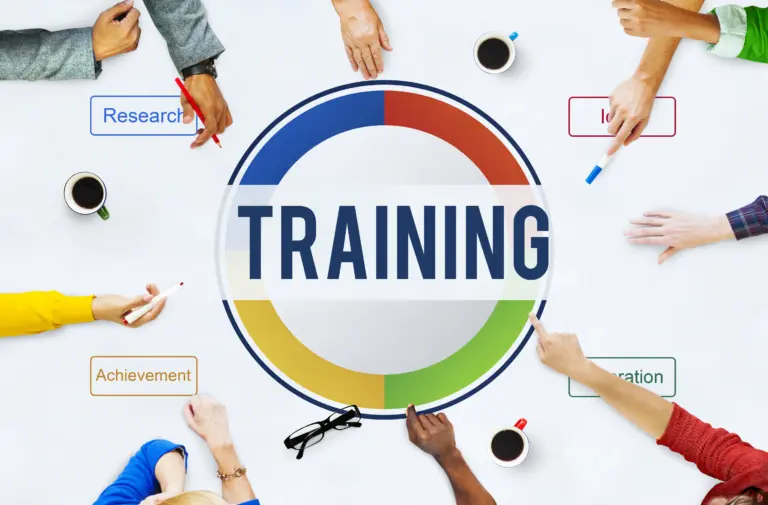Training and development are essential components of any organization’s growth strategy. These processes are not just about enhancing the skills of individual employees; they’re key to the long-term success of the entire company. Understanding the training and development meaning can help both employers and employees realize the value these programs bring. In this article, we’ll explore the definitions of training and development, their benefits, and the evolving trends that are shaping the future of workplace learning.
What is Training and Development?

At its core, training and development are practices that organizations use to improve employee performance and skills. Though often used interchangeably, training and development refer to distinct aspects:
- Training: This is the process of teaching employees specific skills or knowledge to help them perform their current roles more effectively. It’s often short-term, focused, and task-specific.
- Development: Development, on the other hand, is a broader, long-term approach. It involves preparing employees for future roles or leadership positions, fostering their overall growth.
Both training and development are integral to employee success, enabling individuals to keep up with changing job demands and advancements in the industry.
The Meaning of Training in HRM
In Human Resource Management (HRM), training refers to the process of improving employees’ skills and competencies to meet job requirements. HRM teams design training programs to boost employees’ efficiency and productivity in their current roles.
Training can be done through various methods, including:
- Workshops and seminars
- On-the-job training
- Online courses
For HR professionals, training in HRM is an ongoing task that supports both individual growth and organizational objectives.
Training and Development Meaning and Definition
The training and development meaning can be defined as an integrated approach to improving employees’ skills and preparing them for both present and future roles.
- Training is about enhancing current job performance.
- Development focuses on preparing employees for future challenges and leadership roles.
In essence, T&D is not just about enhancing employees’ skills but also about fostering a culture of continuous learning, where employees are encouraged to develop professionally at all stages of their careers.
Learning and Development Meaning (L&D)
Learning and development (L&D) is a broader concept that encompasses both training and development. It focuses on ongoing learning processes that help employees acquire new skills, adapt to changes, and advance in their careers. L&D teams are responsible for creating and managing these programs to ensure that the workforce remains competitive and innovative.
# L&D Team Meaning refers to the group of professionals within an organization responsible for managing and executing training and development programs. Their primary role is to enhance employee skills and knowledge, ensuring that the workforce is well-equipped to meet both current and future job demands.
I was able to implement the platform on my own. It helps in assigning the tasks to other employees, conducting surveys and polls, and much more. The ease of use and self-onboarding is something that I would like to appreciate.
Sonali, Kommunicate
Zimyo simplifies attendance management for our organization. The leave and attendance are so streamlined that we have never faced any difficulties with the system.
Anurag, Eggoz Nutrition
The Role of Learning and Development (L&D) Teams
The L&D team (Learning and Development team) is responsible for designing, implementing, and overseeing training and development programs. These teams ensure that the learning strategies align with the company’s goals and objectives.
A well-structured L&D team:
- Creates learning paths tailored to individual roles
- Designs programs that develop both hard (technical) and soft (interpersonal) skills
- Promotes employee engagement through continuous learning opportunities
L&D professionals work hand-in-hand with HR departments to identify skill gaps and provide relevant training programs that not only enhance performance but also boost job satisfaction.
Why is Training and Development Important?
Training and development are critical for both employees and organizations. Here’s why:
- Boosting Employee Performance: Well-trained employees are more efficient, accurate, and confident in their roles, which leads to better overall performance.
- Employee Retention: Offering development opportunities can significantly improve employee satisfaction, loyalty, and retention. When employees feel supported in their growth, they are less likely to leave.
- Increased Productivity: Employees with updated skills are better equipped to handle tasks, resulting in improved productivity and quality of work.
- Career Growth: Development programs provide employees with the tools they need to advance in their careers, which can also serve as a motivator for improved performance.
When done correctly, T&D programs create a win-win situation, where both employees and organizations reap the benefits.
Emerging Trends in Training and Development
The landscape of training and development is constantly evolving, driven by technological advancements and changing workplace dynamics. Here are some of the key trends shaping the future of workplace learning:
- Digital Learning: With the rise of remote work and e-learning, organizations are increasingly turning to online platforms and tools to deliver training. This includes everything from virtual classrooms to on-demand courses.
- Microlearning: Microlearning focuses on delivering small, digestible chunks of information, often through videos or interactive modules. This method caters to busy professionals and has been shown to improve retention.
- Soft Skills Training: In addition to technical skills, there’s a growing emphasis on developing soft skills such as leadership, emotional intelligence, and communication. These skills are crucial for building strong, collaborative teams.
- Employee Well-being: Mental health and well-being are becoming an integral part of development programs. Training employees on stress management, mindfulness, and work-life balance is essential for overall success.
These trends not only reflect the changing needs of organizations but also highlight the importance of staying agile in the fast-paced modern workplace.
Measuring the Success of Training and Development Programs
Evaluating the effectiveness of training and development initiatives is essential to ensure they align with organizational goals. Here’s how companies measure T&D success:
- Feedback: Gathering feedback from participants helps determine the relevance and impact of the training program.
- Performance Metrics: Monitoring employee performance before and after training can help assess whether there has been a measurable improvement.
- ROI (Return on Investment): Organizations can also assess the financial return on training investments by comparing the cost of the program to the improvements in productivity and performance.
Tracking these metrics ensures that training programs are both effective and aligned with the company’s objectives.
Understanding training and development meaning is essential for both employers and employees. A well-executed training and development strategy not only enhances employee performance but also fosters career growth, improves retention, and aligns individual goals with organizational objectives. By staying on top of emerging trends and continuously investing in learning, organizations can create a workforce that is adaptable, engaged, and ready to face future challenges.
What is the meaning of training in HRM?
The meaning of training in HRM refers to the process of improving an employee’s skills to meet the requirements of their current job. It’s typically a short-term, task-specific approach to improving job performance.
What’s the difference between training and development?
Training is focused on enhancing current job skills, while development prepares employees for future roles and leadership positions. Development is broader and long-term, while training is immediate and role-specific.
What are some modern trends in training and development?
Some key trends include digital learning platforms, microlearning, soft skills training, and employee well-being programs. These trends focus on providing flexible, engaging, and holistic development opportunities for employees.
Why is training and development essential for organizations?
Training and development are crucial because they improve employee performance, increase job satisfaction, foster career growth, and contribute to the overall success of the organization by enhancing productivity and engagement.



